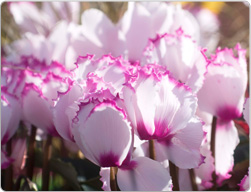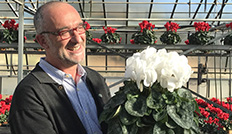 Professional area | Diseases factsheet | Pests | Nematodes : eelworms
Professional area | Diseases factsheet | Pests | Nematodes : eelworms
Various different nematodes are liable to infest cyclamen (cyst nematodes, root-knot nematodes, lesion nematodes, stem and bulb nematode, &c.). Of them all, the most to be feared are Heterodera marioni and H. rostochiensis, both cyst nematodes.
It is possible to take precautions by using commercial bagged compost.
There are effective chemical and biological means of control.
Plant-eating nematodes are microscopic worms, with a maximum size of around 1 mm and a diameter of 0.02 to 0.04 mm. They have a mouth stylet with which they pierce cells and absorb the contents. Depending on species, they infest the aboveground or the underground parts of plants.
Some species of plant parasite nematode get inside the plant tissue in order to spend some considerable part of their life cycle there (endoparasites); others stay at the plant’s surface, in the ground (ectoparasites). There are also semi-endoparasites, which have just a part of their body planted in a root.
In their larval and adult forms the nematodes move in the soil by wavelike motions. To do this they need a film of water and a good loose soil structure. On leaf surfaces, also, they move around by swimming in water.
The nematodes which attack cyclamen along with other plant species are root-knot nematodes, lesion nematodes, cyst nematodes, stem and bulb nematodes and foliar or leaf nematodes.
Among ornamental plants it is the roots of cyclamen, begonias, carnations, roses, gerbera, philodendrons and nursery plants in general which are affected.
These pests belong to the genus Meloidogyne. The main species encountered are M. hapla, M. incognita, M. javanica and M.arenaria. This particular group hardly move through the soil at all. The thread-shaped larvae, 0.5 mm long, are stimulated by exudations from the roots and hatch right by them. They continue to live in the soil in the second larval stage.
They get inside the roots to complete their development (they are sedentary endoparasites) and attach themselves beside the sap vessels which are in the middle of the roots; this sap is what they pump out and live off. The holes they make provoke the formation of giant cells, ending with the production of galls with a diameter of 2 to 4 mm in the case of attack by a single specimen: when there is a multiple attack they can be much larger. The galls serve to protect the nematodes, and are only harmful to the plant. They are arranged in a line and cause deformed root growth, preventing the growth of the root hairs or rootlets, and thus depriving the plant of water. They also interfere with the distribution within the plant of photosynthesis products, and the plant loses its vigour. What is even worse, these galls are more susceptible than healthy roots to soil moulds, and wilting moulds such as Pythium, Fusarium and Rhyzoctonia make the most of their opportunity.
The male nematodes keep their threadlike shape and return to the soil. The females are more ball-shaped, gorged with food. They then lay an average of 600 eggs covered in mucilage. Reproduction can be sexual (as in M. hapla) or parthenogenetic (M. incognita, M. javanica and M. arenaria). In the glasshouse at 28ºC (82ºF) the whole cycle only takes 21 days; so that a plant in the course of its growth can be attacked repeatedly.
These attack a great number of ornamental species: lilies of the valley, lilies, cyclamen, begonias, narcissus, chrysanthemum...
The main pest species are Pratylenchus penetrans (on begonias, cyclamen, narcissus and conifers), P. vulnus (on lilies, lilies of the valley, narcissus, cyclamen), P. scribneri (on chrysanthemum).
Larvae and adults get inside the outer layers of the roots and then force their way deep into the parenchyma of the root-bark. As a result of these endoparasites’ activity, the affected areas are mortified and turn brown or reddish-brown: secondary parasites, as for instance Cylindrocarpon sp., may then invade and extend the damage.
The resulting decrease in the root surface available for absorption means less mineral intake and less water, with metabolic damage. The plant tissue then shows a yellowing in the stem and leaves, and growth is checked.
These nematodes can migrate and set off to seek new plants to feed on or use for the next stage of their life cycle.
Cyclamen are also liable to attack by Heterodera marioni and H. rostochiensis.
In the case of these cyst nematodes, the second-stage larvae are attracted to the roots and penetrate them.
The young larvae destroy epidermal cells; they make their way deep within to insert their stylets into the sap vessels, and they cause the formation of giant cells by injecting hormone-like substances.
The transformation into male or female takes place inside the root. The males, like the young, are worm-like in shape, while the females are round and about 1 mm in size.
After fertilisation the female leaves the root carrying her eggs. She dies and forms a rigid-walled cyst that can be seen with the naked eye. The eggs then develop inside this cyst, and from it the second stage larvae eventually burst forth.
In Europe, stem and bulb nematodes attack many plants, nearly 400 species in all. Among ornamental plants the anemone, begonia, freesia, gladioli, iris, cyclamen and lily of the valley all suffer, as well as many others. There are a number of different zoological groups, with great specialisation of parasite styles. These nematodes do not attack the root system.
Adult Ditylenchus dipsaci (a migrating endoparasite nematode) are without colour and threadlike in shape, 1 mm long. The larval stages measure 0.5 mm to 0.9 mm.
These nematodes hibernate in the soil and in plant debris, as well as in their victims. They penetrate the base of stems through the stomata, at the level of the collar, and feed by absorbing the cytoplasm of the cells through their stylet. They provoke a rotting or deformation of the flower buds and stalks as they develop in the interstitial spaces. The distance between shoots is too short, the leaves are too short and close-spaced, and the collar is swollen; the colour of leaves and flowers is altered, and organs and tissues are spoiled (swelling, rotting, spongy appearance).
After fertilisation the female lays her eggs in the plant tissue. The cycle can be completed in 18 to 20 days at temperatures of around 20ºC (68ºF) to 24ºC (75ºF).
The species of the genus Aphelencoidae are ecto- or endoparasites. The threadlike adults are around 1 mm long.
Their victims are the leaves, leaf buds and meristem: here they feed and reproduce. The nematodes over-winter in soil, in dead leaves and the upper parts of infested plants. On awakening they go back to the leaves. They can move over the leaf surface provided these have a film of water on them. During watering they can also be splashed up onto the leaves with particles of soil. They penetrate by means of the stomata of which there are many on the underside of the leaves.
They feed by means of a stylet from the leaf and flower parenchyma. They can pass through the cells of soft plant tissue, and only the thick membranes of the leaf ribs can keep them out. The infested parts die.
Infestation of stems by leaf nematodes shows as yellowish patches which turn brown or blackish, depending on the plant: it is easy to recognise this damage because it is clearly delimited by the ribs. The leaves dry, wither and blacken while still attached to the stalks. The attack starts in the lower parts or at the top and spreads up or down during wet periods. The plant then suffers a growth check, and the flowers open at the wrong stage, with a burnt look to them.
- choose healthy plants with no signs of attack
- use disinfected compost mixes
- destroy all affected material
- take great care with watering patterns. Isolated plants under glass may spread their infestation by water splashed along rows, or from pot to pot when two neighbouring plants come into contact.
A mould, Arthrobotrys irregularis, that feeds on nematodes (discovered at the INRA centre in Antibes) has the remarkable capacity of catching root-knot nematodes at the mobile larva stage by means of sticky traps made of loops of mycelium. These hold the pest as in a lasso; the mould then invades the whole nematode and kills it. A reference from 1984 names the commercial product as Royal 350, but neither the mould nor the product are listed in the Plant Medication Index for 1997.
The culture must be spread one month before introducing the plants to be protected. The dose is 140 g/m²; once established, the mould persists for several months.
No other reference has been listed.
- steam disinfect soil and growing medium
- set baths of a liquid disinfectant (formalin, dilute bleach) at the glasshouse entrance to destroy nematodes arriving on footwear.
These treatments decrease the nematode population but cannot eradicate it entirely.
The constant development of the regulations and homologations of phytosanitary treatment products, and the differences in regulations according to each country make it impossible for us to include updated information on homologations. Each producer will have to contact his local plant protection bureau to obtain the latest updates concerning the regulations and use of phytosanitary products. We strongly advise testing beforehand on a plant sample in order to measure the chemical’s activity (establishing the dose) and any effect on the plant (plant poisoning).
This advice sheet is based on the methods used at the SCEA at Montourey (Fréjus, France). These procedures may need some modification to adapt them to other climatic situations. Before starting to grow cyclamen there needs to be a review of precautions against pests and diseases. We must point out that our advice and suggestions are offered for information purposes and therefore cannot include any guarantee of specific results; it is a good idea to carry out trials beforehand.

2565, rue de Montourey
83600 Fréjus - France
International telephone : +33 (0)4 94 19 73 04
Switchboard : + 33 (0)4 94 19 73 00
Fax : +33 (0)4 94 19 73 19

